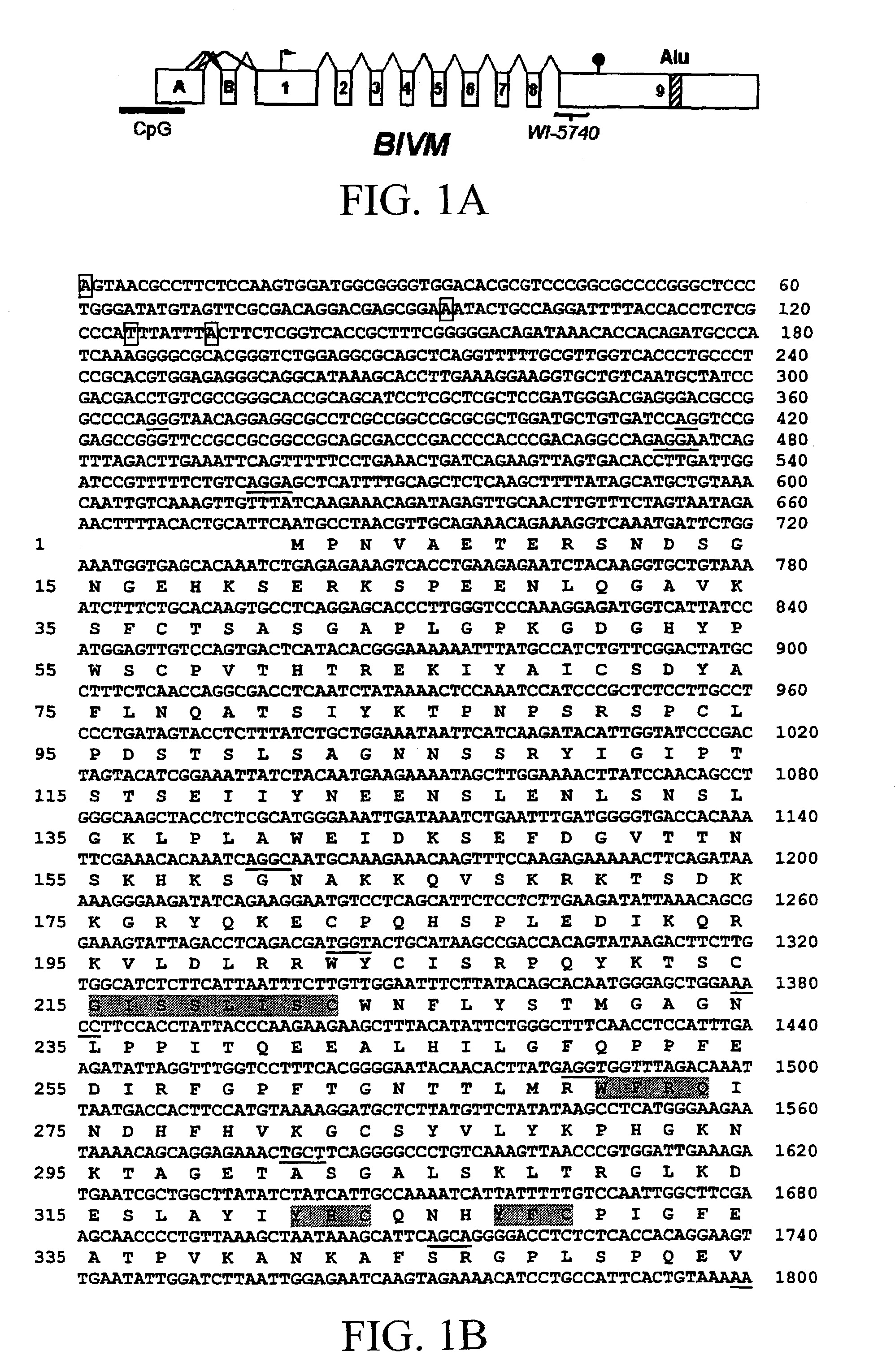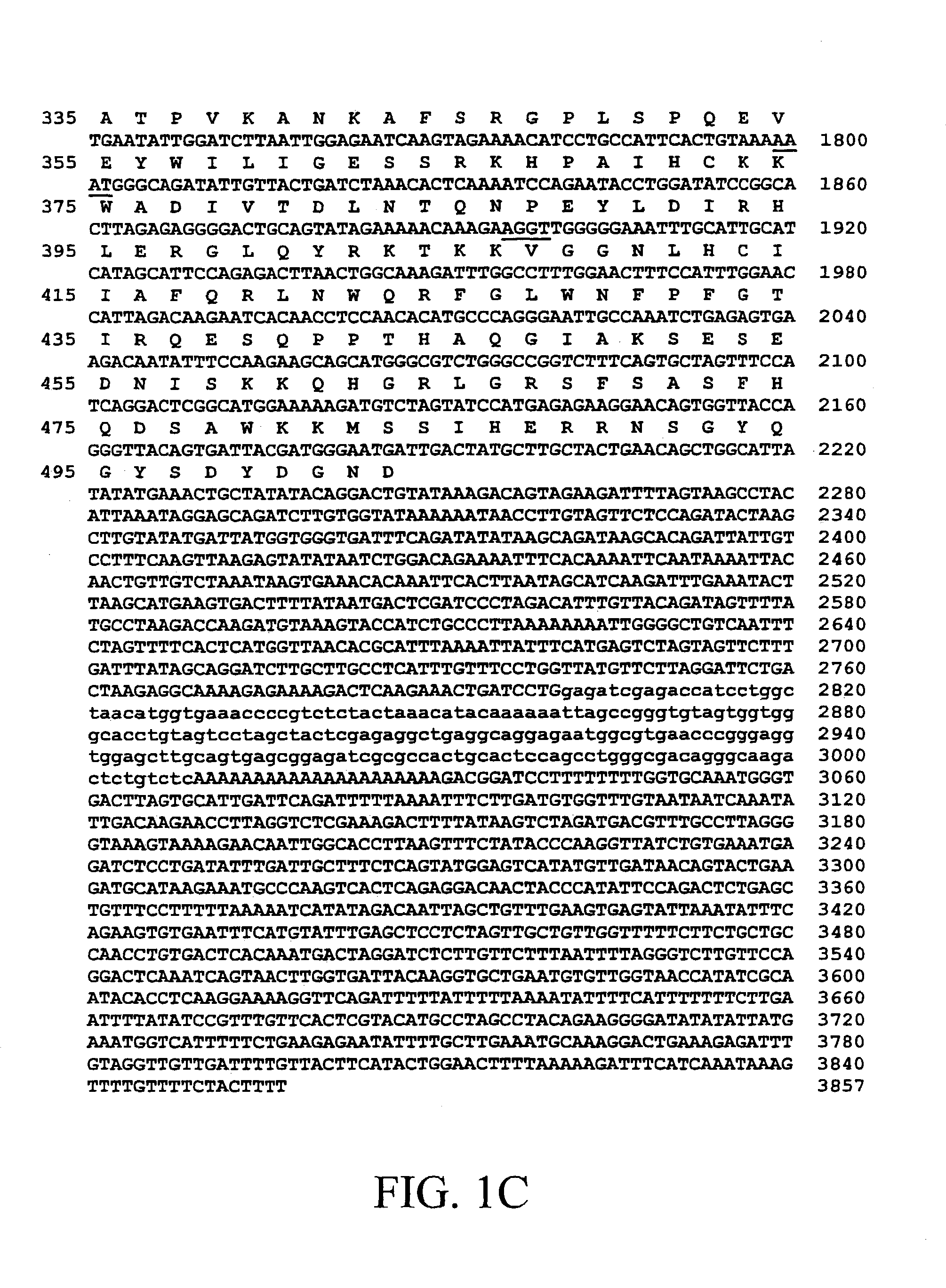BIVM (basic, immunoglobulin-like variable motif-containing) gene, transcriptional products, and uses thereof
a technology of immunoglobulin-like variable and gene, which is applied in the field of basic immunoglobulin-like variable motif-containing gene, transcriptional products, and uses thereof, can solve the problem of lack of significant sequence identity to any group of proteins previously described
- Summary
- Abstract
- Description
- Claims
- Application Information
AI Technical Summary
Benefits of technology
Problems solved by technology
Method used
Image
Examples
example 1
Identification of BIVM
[0146]Human BIVM was identified originally as an EST (IMAGE #785450; GenBank AA449273) that encodes the two short motifs WFRQ (motif 2 [M2]) and YFC (motif 3a [M3a]), which correspond to framework region 2 (FR2) and FR3 of an Ig V domain, respectively (Barclay, A. N., et al. [1997]The Leucocyte Antigen FactsBook, Academic Press, San Diego). The W in M2 and C in M3a correspond to W41 and C104 of the IMGT numbering system. Complete sequencing of this EST, overlapping ESTs (IMAGE #2184889, GenBank AI538125; IMAGE 136117, GenBank R33273; IMAGE 1060823, GenBank AA568610; and IMAGE 785450, GenBank AA449273) and RACE strategies were used to resolve the complete mRNA sequence.
[0147]Human BIVM mRNA is 3857 nucleotides and encodes a 503 amino acid protein (FIG. 1). No proteins with significant identities (E<0.01) to BIVM have been identified using BLAST analyses. Searches of current motif databases (BLOCKS, PRINTS, Conserved Domain Database, Domain Architecture Retrieval...
example 2
Genomic Organization of BIVM
[0150]GeneBridge 4 radiation hybrid panel mapping (Gyapay, G., et al. [1996]“A Radiation Hybrid Map of the Human Genome,”Hum Mol Genet 5:339–346) localized BIVM on chromosome 13q32–33 (data not shown). Examination of the publicly available Human Genome Project database revealed the exon-intron structure of BIVM. A 5′ truncated BIVM sequence (hypothetical protein FLJ20159) was initially placed on the publicly available human genome map at 13q14–q21. The 5′ untranslated region of BIVM consists of two separate exons (designated exons A and B), followed by the coding region consisting of nine exons; the exon / intron boundaries are indicated in Table I.
[0151]Inspection of genomic sequence localizes BIVM between ERCC5 and “hypothetical protein” MGC5302, a human ortholog of the gene encoding the mouse protein Kdel1 / EP58 (Kimata, Y., et al. [2000]“Identification of a Novel Mammalian Endoplasmicreticulum-Resident KDEL Protein Using an EST Database Motif Search,”Gen...
example 3
BIVM is Highly Conserved within Deuterostome Species
[0153]BIVM orthologs were identified in: mouse, chicken, Xenopus and zebrafish in order to address its potential phylogenetic conservation, as well as to define conserved motifs potentially relevant to function. In addition, a partial sequence for a BIVM ortholog was identified in sea urchin. The identity of the human BIVM protein to these orthologs ranges from 35–87% overall and is consistent with the phylogenetic relationships of the species considered (FIG. 3; see below). The C-terminal region of BIVM shares the highest degree of interspecific sequence identity. The N-terminus of this peptide domain is RK(V / C)LD and the C-terminus is GGNLHC. This region includes all of the V domain motifs, and is 220 amino acids in human (indicated by arrowheads in FIG. 3).
[0154]The corresponding domains in mouse, chicken, Xenopus, zebrafish and sea urchin are 97%, 91%, 91%, 87% and 64% identical to the human domain, respectively. In addition, B...
PUM
| Property | Measurement | Unit |
|---|---|---|
| melting temperature | aaaaa | aaaaa |
| Tm | aaaaa | aaaaa |
| temperature | aaaaa | aaaaa |
Abstract
Description
Claims
Application Information
 Login to View More
Login to View More - R&D
- Intellectual Property
- Life Sciences
- Materials
- Tech Scout
- Unparalleled Data Quality
- Higher Quality Content
- 60% Fewer Hallucinations
Browse by: Latest US Patents, China's latest patents, Technical Efficacy Thesaurus, Application Domain, Technology Topic, Popular Technical Reports.
© 2025 PatSnap. All rights reserved.Legal|Privacy policy|Modern Slavery Act Transparency Statement|Sitemap|About US| Contact US: help@patsnap.com



